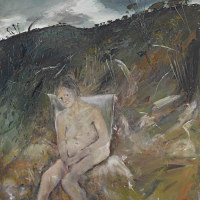60. ARTHUR BOYD Figure in Landscape

In 1970 Arthur Boyd had completed the Nebuchadnezzar series, one of the defining groups of paintings in this distinguished artists career. These large brightly coloured and fundamentally literary works sharply contrast with equally important landscapes, some with figures, which Boyd produced in the following years. These landscapes represent a return to one of Boyds core interests and exemplify the binary nature of this restlessly productive artist. One minute he is deftly probing the boundaries of allegory with metaphysical pyrotechnics, next minute he brings the same technical flourish to work which is naturalistic, earthy, and almost homely. This was a characteristic of his work since the earliest days of his career. Throughout, his work relied on the way one extreme is illuminated by an admixture of the other. In this respect he is following in the footsteps of the artist who was one of the most important influences in his early years, the Flemish artist Pieter Bruegel the Elder (c1525- 1569).
Figure in Landscape belongs to an extended group of works painted through 1972, shortly after Boyd had (after twelve years residence in England) returned to Australia and following his momentous visit to art dealer Frank McDonalds farm at Bundanon. This was Boyds first visit to the area that was to become the most important subject of his later career. Initially however, the visit resulted in Riverbank, a small, relatively modest landscape painting now in the National Gallery of Australia collection. This discrete little painting, produced on a hot summers day on the river in front of the property, is the fountainhead of much of Boyds later work, and the origin of his highly successful and enduring Shoalhaven paintings.
Figure in Landscape, painted a short time later, is a remarkable example of the naturalistic tendency in Boyds work. It also makes references to some of his favourite painters: Rembrandt (1606-1669), Manet (1832-1883) and Tintoretto (1518-1595), all artists known for painting nude bathers in the landscape, often using the biblical subject of Susannah and the Elders. In this case the nude is Yvonne, Boyds wife. The figure has the dignity of a classical nude, and yet she is painted naturalistically to a fault - rather warts-and-all, and possibly erring on the wrong side of chivalry, but nonetheless remarkably direct and uncompromising. In the background we see the same ridgeline as Riverbank, gently undulating but distinctive. This ridgeline, subtle yet insistent, is the prototype of its more developed version, the Shoalhaven Pulpit Rock, which was through Boyds work to become one of the best recognised landmarks in Australian art.
Although the subject of this painting is clearly a nude, Figure in Landscape, like other examples of this series gives as much weight to the figure as its surroundings. In the case of this painting, the figure can be seen to tonally merge with the foreground leaving as the principal focus the upper area of the composition.
With both Riverbank and Figure in Landscape we are witnesses to Boyds quest for a landscape subject capable of performing the function of a visual anchor to a composition. In this respect these landscapes of the early 1970s, which at first recall the work of Fred Williams (1927-1982), increasingly refer to Sidney Nolans (1917-1992) Kelly series and Albert Tuckers (1914-1999) Explorers. The quest, which coincided with his discovery of the Shoalhaven River, provided the endlessly experimental Boyd with a subject and a motif which would prove a rich source of inspiration and one that he could deploy at will and to great effect in the coming years.
Timothy Abdallah BA